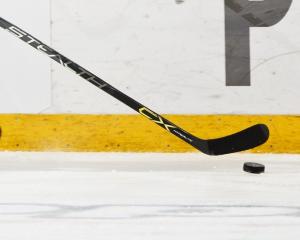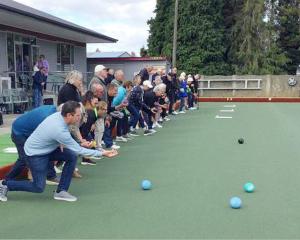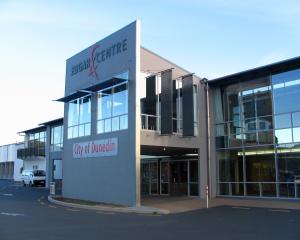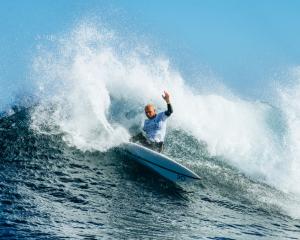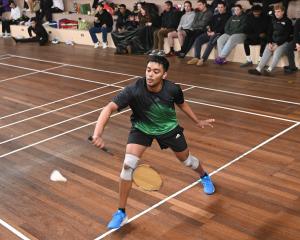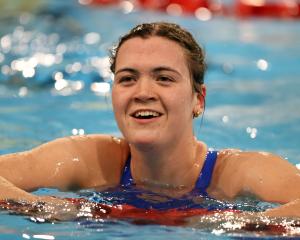Sandra McGookin was a six-time New Zealand javelin champion and competed at the 1974 Commonwealth Games. But these days, she is quite happy to be known as the grandmother of rising basketballer Sam Timmins. Hayden Meikle talks to a North Otago athletics great.
HAYDEN MEIKLE: Where did you grow up?
SANDRA McGOOKIN: Waitaki Bridge. I went to primary school out there with about 12 pupils. Then I went to Waitaki Girls'.
HM: What did your parents do?
SM: They owned the Georgetown store for three or four years. I was 6 months old when they moved to a poultry farm, right out the mouth of the river.
HM: You did your fair share of work on the farm after school, I presume?
SM: Hah, not a lot, no.
HM: Sisters? Brothers?
SM: A sister, Lynley Brooker. She lives in Oamaru. Two brothers. Russell Goodsir lives in Oamaru, and Neville's in Timaru. I was the youngest.
HM: Was sport a big thing for you as a child?
SM: Yeah, Mum was really good at sport. She represented Otago at table tennis and tennis. She played a lot of tennis locally, and she was also a very good netballer. Mum was the sporty one. Dad was a fireman in Dunedin, originally. When he was on the farm, he didn't have time for sport.
HM: What was your first foray into organised sport?
SM: It was way back in the day when they had sports at Enfield. Kids came from all around to have a go at things. There was another thrower there, Winnie Richards. I think she was a New Zealand champion. She saw me there and encouraged me to concentrate on javelin. After I left high school, I started working with Graham Merrilees, who had come up from Dunedin to work at Stringer and Co. He was their accountant, I think. He was a very good javelin thrower. I think he was New Zealand junior champion before he damaged his elbow. I was in the Otago team but I was pretty lazy at training, and I was getting beaten regularly by my rival, Sally Mene. Graham sort of took me under his wing. If not for him, I probably wouldn't have achieved anything. He was a really staunch coach. He made me train every day. I needed somebody like him to take over. Technically, he was very good. I wasn't very big but he taught me good technique. That was the difference. We didn't have access to weight training or anything. There might have been some weights at the rowing club but that was it.
HM: Did you have a go at discus or shot put or anything else?
SM: I dabbled with the other field events but nothing major.
HM: Where did you train?
SM: Centennial Park. Every night after work. Either Mum would come and pick me up or I would get the car and drive myself home to Waitaki Bridge. I couldn't have done anything without Mum's dedication. She was amazing. She went everywhere with me. I went to the national championships when I was about 15. I think I went for five years before I won a title.
HM: Was javelin a lonely pursuit?
SM: No, it wasn't. We had a very big club here. Athletics was a big thing in those days. Lots of others were training at the same time, and we travelled around together. It was like being part of a team.
HM: And it was no problem staying in North Otago?
SM: There was always talk about moving north. Les Mills and his wife, Colleen, wanted me to go to Auckland. But that wasn't where I wanted to be. I loved going up for a while, but I loved coming home.
HM: When did you represent New Zealand for the first time?
SM: I went to Australia to compete in what they called the R H North Cup. That must have been 1972. That and the 1974 Commonwealth Games was basically it. They did a New Zealand Games a year or so after the Commonwealth Games. It was back in Christchurch and it was quite a big event.
HM: Did you ever come close to Olympic selection?
SM: No, not really. I was probably about 10m away from qualifying.
HM: What are your memories of the 1974 Commonwealth Games in Christchurch?
SM: That's a long time ago. I really enjoyed the team side of it, and staying in the village. The New Zealand team was like one big happy family. It was a big deal for Christchurch. I was there the day Dick Tayler won his gold medal. That really set it alight. It was amazing.
HM: Did you get nervous before competition?
SM: Yeah, I was a bit nervous for the Commonwealth Games. It was also tricky because our daughter, Karen, was about 6 months old. Mum stepped in again.
HM: Had it been difficult, balancing training with motherhood?
SM: Once I got married, we were on the farm. There were times when Ron, my husband, could look after Karen while I trained. I did a lot of training on the farm. Mowed a strip and had a run-up in a paddock. You just worked around things.
HM: How long after 1974 did you keep competing?
SM: I had Paula, our other daughter, a couple of years later. So it was just a bit later when I pulled the pin on it.
HM: Any regrets?
SM: I would have liked to have had the access to the facilities they have today. Most of the ones from my era probably look back and think, gee, imagine if you didn't have to work and could just go and train. But I loved every bit of it. Loved being part of the Otago team. Had a lot of fun.
HM: Any injuries?
SM: All that throwing damaged my back. I had to have an operation.
HM: How do you throw a javelin?
SM: Basically, you have to have a natural overarm throwing action. And not everybody has. Especially women. That's why the Americans are so good because they do a lot of baseball and softball throwing. I grew up down the mouth of the Waitaki, throwing stones at birds.
HM: So it's about technique, not just brute strength?
SM: A lot of it is technique. It's all very well building up bulk, but it can slow you down. It's all about the speed of the arm as you whip it through, and getting everything in the right place at the right time as you throw over the top of your prop leg. It's not a natural thing.
HM: Did you strike any barriers because you were a woman?
SM: No, there weren't any, really. The barriers we struck were because we lived down this far in the South Island. They would bypass you for selection. I was quite often a non-travelling reserve, because they had to fly me to Auckland.
HM: Did you do any coaching after your playing career ended?
SM: Yeah, I've done a bit at the local club. Enjoyed doing that, when I could.
HM: Did you play any other sport?
SM: I played a lot of basketball. That was probably my passion. It was very strong in this area. I played for Otago at under-18 level and won the national title.
HM: Do you play any sport now?
SM: Golf. I play at the Lower Waitaki club. My handicap is about 17 at the moment. I've won the silver championship the past two years.
HM: Your grandson is Sam Timmins, this very exciting young basketball player. How are you enjoying watching him develop?
SM: Oh, really enjoying watching Sam. We take any opportunity we can get to see him play.
HM: Did Sam ever dabble in athletics?
SM: Yes, he did. He had a brief go at the javelin and he was a very good discus thrower. Good high jumper, too.
HM: Do you see any traits in Sam that he might have inherited from his grandmother?
SM: Yeah, I don't know how to explain it. I had a fairly strong desire to achieve and be as good as I could at my sport. I wanted to win. And he's a very focused young man. It's really nice to see a young person with that drive. You see young ones who are good, but don't have that extra drive to be very good. Sam's sister, Ruby, has also got a lot of sporting ability. She's got some very good skills.
HM: Your husband, Ron, might have to claim some credit, too.
SM: He played rugby for North Otago and got called up for an All Black trial once. He was too busy on the farm or something. He was a lock, a very good rugby player. You wonder how good he could have been.



